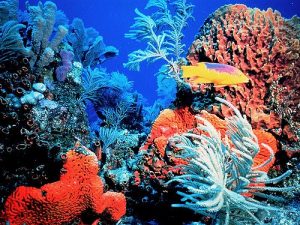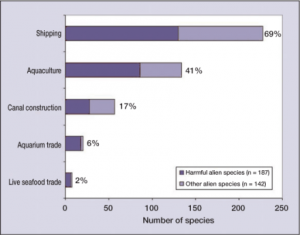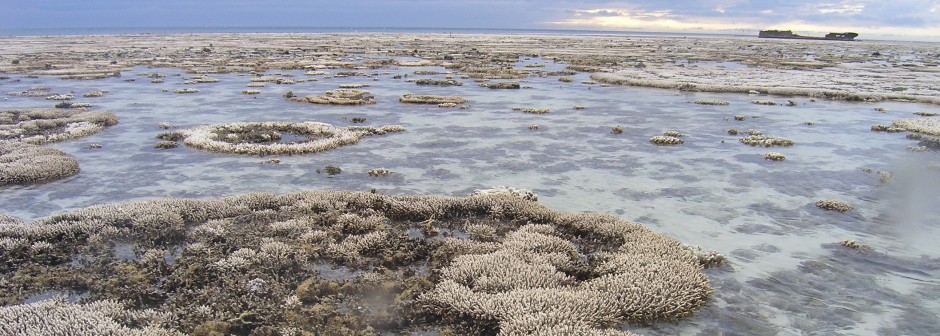They call the United States the melting pot because the country is a perfect example of diversity. But, it is not only the land that houses such diversity, the oceans that surround the U.S. are also homes to highly biodiverse coral reef ecosystems (Figure 1). When we look at pamphlets of tropical tourist destinations, generally the first thing that comes to mind are the vibrant reefs and marine life we would get to see during snorkeling or scuba diving excursions. What would happen if these reefs turned a pastel white and no longer supported the beautiful fish and sea creatures that we are so used to seeing in pictures? This is a fear environmentalists are facing today and is important to address.

Figure 1. Image of coral reef habitat in Florida Keys. Source: Flickr1
Complex reef ecosystems are easily disturbed when either biotic or abiotic factors are changed. One major example of a biotic factor that may skew the balance of coral reef habitats are invasive species. What is an invasive species? Well, an invasive species, also known as an alien species, invades a habitat that it is not native to. As methods of transportation have progressed over the past few centuries, introduction of invasive non-native species has increased dramatically – with new foreign species establishing once every 32 to 85 weeks at ports in countries such as the U.S., Australia, and New Zealand. 2 The difference between invasive and other foreign species is that while invasive species take over the native species of the habitat, other foreign species are integrated into the new habitat without damaging the natural balance of the marine ecosystem.2
The introduction of invasive species can be broken down into three different groups according to Molnar et al.
- Transportation-Related Pathways – including movement of ballast water, fouling, and canals connecting water ways.3 (The advent of ship vessels and travel across oceans introduced processes such as fouling, in which organisms attach to ship vessels, and ballast water tanks on ships, which introduce new species through the recycling of water in the tanks. 4)
- Commerce in Living Organisms Pathways – including live seafood trade and aquaculture.3
- Other Human-Assisted Pathways – including climate change.3
Figure 2, below, shows the number of invasive species introduced through some of the most common human-assisted pathways. These processes of introduction of invasive species show the role we play in disturbing the biodiversity make up of reef habitats. Understanding the unintentional impact we may have on the marine ecosystem is the first step towards protecting and restoring native marine habitats.

Figure 2. Breakdown of the most common methods of introduction of invasive species and other foreign species. Source: Ecological Society of America3
So how serious is the damage being done by alien species? Invasive species have the ability to take over other native species and potentially even eradicate native species. The disturbance of a single species also influences other species interactions and therefore can upset the balance of that specific ecosystem. For example, the invasion of the New Zealand screw shell, in Tasmania, had the effect of changing the seabed habitat by introducing attaching points for other species and hiding spaces for hermit crabs, in turn, shifting the food web. 2 Alien species not only have an ecological impact, but can also have an economic impact. While the Chinese mitten crab may disturb natural habitats and compete with native species, it also damages fishing gears and river banks (Figure 3).5 The invasion of the comb jelly in the Black Sea has also led to the demise of coastal fisheries while ballast water can transport viral and bacterial pathogens such as those that may cause cholera.2 Clearly alien species have the potential of causing high ecological and economical damage.

Figure 3. Map of Chinese Mitten Crab Invasion using data from 2008. Red circles represent established population in non-native range, blue circles represent non-established populations in non-native range, and green circles represent populations in native range. Source: Journal of Marine Biology and Ecology6
Acknowledging the harmful effects human activity may have on the marine ecosystem is vital. Several different pathways have led to the introduction of invasive species, and there are currently 44 invasive species that have high ecological impact in the North Atlantic.5 In my next few blog posts, I will delve deeper into interesting cases related to specific invasive species that have had, or potentially may have, the effect of critically damaging the reef habitats around the coasts of the United States.
References:
1 TiagooOOooOO. “Coral_Reef%2C_Florida_Keys[1].” Flickr. Yahoo!, 10 Oct. 2007. Web. 20 Feb. 2017. <https://www.flickr.com/photos/14850624@N06/1537421470/>.
2 Bax, Nicholas, Angela Williamson, Max Aguero, Exequiel Gonzalez, and Warren Geeves. “Marine Invasive Alien Species: A Threat to Global Biodiversity.” Marine Invasive Alien Species: A Threat to Global Biodiversity. Marine Policy, 23 May 2003. Web. 14 Feb. 2017. <http://www.sciencedirect.com/science/article/pii/S0308597X03000411>.
3 Molnar, Jennifer L., Rebecca L. Gamboa, Carmen Revenga, and Mark D. Spalding. “Assessing the Global Threat of Invasive Species to Marine Biodiversity.” Wiley Online Library. Ecological Society of America, 1 Nov. 2008. Web. 15 Feb. 2017. <http://onlinelibrary.wiley.com.ezproxy.rice.edu/doi/10.1890/070064/full>.
4 Hulme, Philip E. “Trade, Transport and Trouble: Managing Invasive Species Pathways in an Era of Globalization.” Journal of Applied Ecology – Wiley Online Library. British Ecological Society, 14 Jan. 2009. Web. 17 Feb. 2017. <http://onlinelibrary.wiley.com/doi/10.1111/j.1365-2664.2008.01600.x/full>.
5 Plymouth University. “Forty-four invading species ‘loose’ in North Atlantic.” ScienceDaily. ScienceDaily, 30 January 2017. <www.sciencedaily.com/releases/2017/01/170130100807.htm>.
6 Dittel, Ana I., and Charles E. Epifanio. “Invasion Biology of the Chinese Mitten Crab Eriochier Sinensis: A Brief Review.” Invasion Biology of the Chinese Mitten Crab Eriochier Sinensis: A Brief Review. Journal of Experimental Marine Biology and Ecology, 17 May 2009. Web. 20 Feb. 2017. <http://www.sciencedirect.com/science/article/pii/S0022098109001415>.

